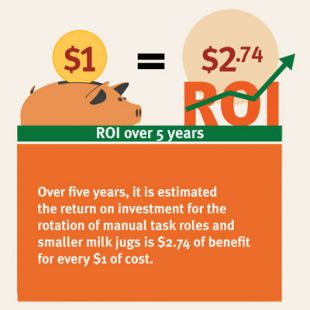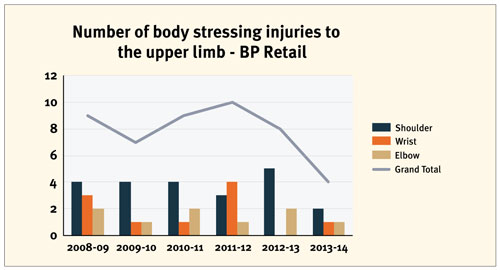Rotation of manual task roles and smaller milk jugs - BP Retail Wild Bean Cafes

Background
BP is engaged in the exploration for and production of oil, natural gas and liquefied natural gas, and the refining, transportation and marketing of petroleum products. BP is also responsible for a number of coffee making facilities as part of retail activities at its travel centres. Some of these travel centres experience high volumes of coffee production, with approximately 140 coffees produced per hour during peak periods. These high volume sites include Wild Bean Cafes based at travel centres across South-East Queensland.
The main work health and safety issues for Wild Bean Cafes involved the repetition of each task and the duration of time spent on making coffee. Injuries to the upper limbs (wrist, elbows and shoulders) were experienced by some baristas as a result of repetitive movements, which included handling milk jugs to texture milk.
The company addressed these issues by:
- replacing two litre milk jugs with one litre milk jugs for texturing milk, to reduce the strain from repetitive handling by baristas
- implementing a rotation system requiring workers to rotate manual task roles every 30 minutes. These tasks included producing coffee shots, texturing milk and operating the registers.
The intervention was implemented over three months as part of Workplace Health and Safety Queensland's Participative Ergonomics for Manual Tasks (PErforM) program. The consultation phase involved BP's health, safety, security and environment (HSSE) committee and the retail national safety manager. BP plans to formalise the rotation of tasks by putting in place a policy with written guidelines.
Benefits
The benefits of the intervention included the following:
- A reduction in upper limb injuries from body stressing (repetitive movements) by approximately 56 per cent. This intervention assisted in mitigating upper limb injuries before the injury became quite severe and costly to the employer.
- The number of accepted body stressing workers' compensation claims involving the upper limbs (shoulder, wrist and elbow) decreased by 43 per cent from 2012–13 to 2013–14 (Figure 1). The significant reduction in the second year is likely the result of the intervention becoming more embedded in the work practices. It is expected that approximately 80 to 90 per cent of the reduction in injuries is attributed to the intervention.

Figure 1- Number of body stressing injuries to the upper limb - BP Retail
Intangible benefits included the increased motivation of staff from cross-skilling.
The duties are distributed more equally across workers as a result of the 30 minute rotation.
Costs
Costs include:
- upfront costs of staff time for involvement in PErforM and training plus the purchase of new milk frothing jugs, totalling $1,180
- ongoing costs of staff time for training and program monitoring and other ongoing costs totalling $6,700.
Return on investment
Over a five year period, the changes made by BP Retail are estimated to provide a return on investment of around $2.74 of benefits for every $1 of expenditure.
The upfront costs of the intervention were effectively paid back by the ongoing net benefits of the intervention in around five weeks.
Data and assumptions in ROI calculation - BP Retail Wild Bean Cafes
| Item | Value | Calculation details |
|---|---|---|
| Upfront costs | ||
| Initial implementation costs | $200 | BP estimates |
| Problem identification and intervention development costs | $200 | BP estimates |
| Training costs | $120 | BP estimates |
| Other upfront costs | $660 | BP estimates |
| Total upfront costs | $1,180 | |
| Ongoing costs (annual) | ||
| Training | $3,600 | BP estimates |
| Program monitoring | $600 | BP estimates |
| Other | $2,500 | BP estimates |
| Total ongoing costs | $6,700 | |
| Benefits (annual) | ||
| Injury reduction | $9,120 |
Assumptions :
|
| Avoided indirect costs of injuries (e.g. lost productivity) | $9,915 |
Assumptions on a per month basis:
|
| Total annual benefits | $19,035 | |
| Return on investment | ||
| $ of benefits per $1 of costs over five years | $2.74 | |
| Payback period for upfront costs | 5 weeks | |
Source: Adept Economics, 2015.
This is a high-level analysis and should not be relied upon in making any future business decisions. Proponents are strongly urged to make their own estimates and decisions based on their individual business modelling.
Further information
View further information on return on investment for work health and safety interventions.